A preprocessor directive is a line of code in the C# programming language that provides instructions to the C# compiler. These directives are not part of the program code itself, but are instructions to the compiler on compiling the code. Preprocessor directives begin with a hash symbol (#) and are usually placed at the beginning of a source program.

Preprocessor directives are used to define macros, include files, or conditionally compile code. They are used to inject information into the compilation process. By using preprocessor directives, you can do things such as include headers, define constants, and skip parts of the code during compilation.
Macros are used to give names to constants, code fragments, and other values. They can replace certain code fragments with shorter, easier-to-use names. This can help reduce typing and make programs more efficient.
Including files is one of the most common uses of preprocessor directives. This allows you to include other source files in your program. This can be useful for breaking a large program into smaller, more manageable pieces. It can also be used to include libraries and other third-party code.
Conditional compilation is another useful preprocessor directive. This allows you to compile code based on certain conditions. For example, you can use a preprocessor directive to compile code only if a certain condition is met. This can be useful for writing code specific to certain platforms or versions of the C# compiler.
Preprocessor directives are a powerful tool for making your code more efficient and easier to read. They can be used to simplify your code and to make it easier to maintain. However, they should be used with caution, as they can lead to hard-to-debug errors if used incorrectly.